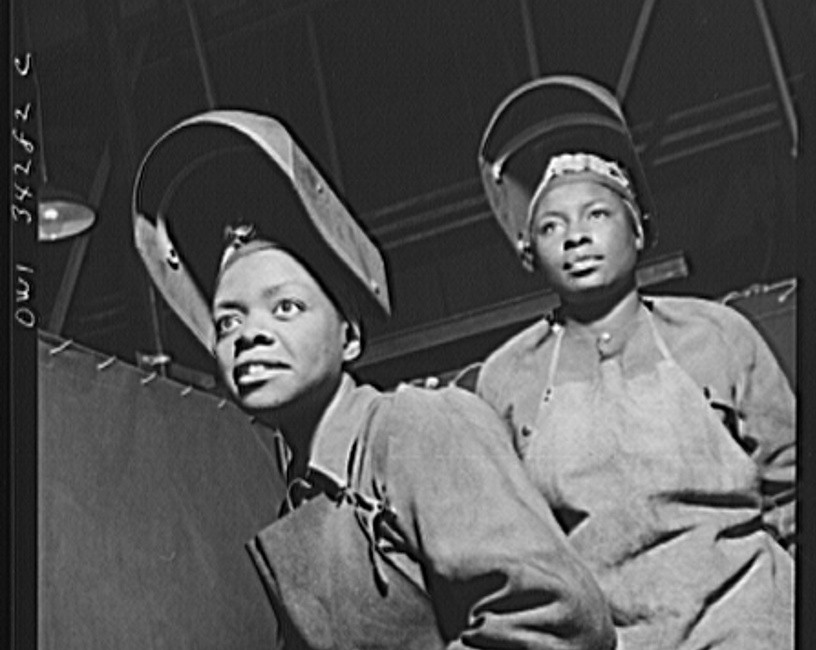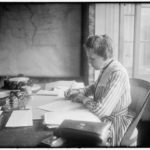From their unsung labors to society-changing accomplishments, Connecticut’s women have contributed to diversified fields of endeavor. During colonial times, they kept farms, homes, and businesses running—despite restrictions that then, and long after, barred them from the same rights as men. Among those pioneering national and local change in the 1800s are educator-abolitionist (and state heroine) Prudence Crandall and women’s suffrage advocate Isabella Beecher Hooker. Twentieth-century notables include Mary Townsend Seymour, champion of African Americans’ civil rights, and Ella Grasso, first woman to be elected a US governor in her own right. Today, the Connecticut Women’s Heritage Trail connects new generations to the histories of these and other women.
Featured
Ida Tarbell became one of the most famous "muckraking" journalists in 19th century America, thanks largely to her investigation of the Standard Oil Company. …[more]
Learn More
58529
BTH8RJJV
1
apsa
50
default
5694
https://connecticuthistory.org/wp-content/plugins/zotpress/
%7B%22status%22%3A%22success%22%2C%22updateneeded%22%3Afalse%2C%22instance%22%3Afalse%2C%22meta%22%3A%7B%22request_last%22%3A0%2C%22request_next%22%3A0%2C%22used_cache%22%3Atrue%7D%2C%22data%22%3A%5B%7B%22key%22%3A%227NTTNIDA%22%2C%22library%22%3A%7B%22id%22%3A58529%7D%2C%22meta%22%3A%7B%22lastModifiedByUser%22%3A%7B%22id%22%3A14399323%2C%22username%22%3A%22kquotap%22%2C%22name%22%3A%22%22%2C%22links%22%3A%7B%22alternate%22%3A%7B%22href%22%3A%22https%3A%5C%2F%5C%2Fwww.zotero.org%5C%2Fkquotap%22%2C%22type%22%3A%22text%5C%2Fhtml%22%7D%7D%7D%2C%22numChildren%22%3A0%7D%2C%22bib%22%3A%22%3Cdiv%20class%3D%5C%22csl-bib-body%5C%22%20style%3D%5C%22line-height%3A%201.35%3B%20padding-left%3A%201em%3B%20text-indent%3A-1em%3B%5C%22%3E%5Cn%20%20%3Cdiv%20class%3D%5C%22csl-entry%5C%22%3E%26%23x201C%3BConnecticut%20Women%26%23x2019%3Bs%20Hall%20of%20Fame.%26%23x201D%3B%20%3Ca%20class%3D%27zp-ItemURL%27%20href%3D%27http%3A%5C%2F%5C%2Fwww.cwhf.org%5C%2F%27%3Ehttp%3A%5C%2F%5C%2Fwww.cwhf.org%5C%2F%3C%5C%2Fa%3E%20%28March%209%2C%202012%29.%3C%5C%2Fdiv%3E%5Cn%3C%5C%2Fdiv%3E%22%2C%22data%22%3A%7B%22itemType%22%3A%22webpage%22%2C%22title%22%3A%22Connecticut%20Women%27s%20Hall%20of%20Fame%22%2C%22creators%22%3A%5B%5D%2C%22abstractNote%22%3A%22%22%2C%22date%22%3A%22%22%2C%22url%22%3A%22http%3A%5C%2F%5C%2Fwww.cwhf.org%5C%2F%22%2C%22language%22%3A%22%22%2C%22collections%22%3A%5B%228THZZ754%22%2C%22BTH8RJJV%22%2C%225F5984C9%22%2C%22XZAHUTPI%22%2C%22BG4RZD2W%22%2C%22IAZM4I28%22%2C%2274Q6FQ73%22%2C%22GIQ9PJQX%22%2C%22PK7RW4PR%22%2C%22DMQ2M63J%22%2C%223DTATNE2%22%2C%227HPNMAPV%22%2C%22UPPMQ8P6%22%2C%22ETTUCQH9%22%2C%22VG32H9CI%22%2C%22V42ARCTS%22%2C%22TNG8JWZE%22%2C%22C2XTNRE6%22%2C%22Q4V3FAJJ%22%2C%22G6CDQA2K%22%2C%223AVQZV8X%22%2C%22JHFNZAJH%22%5D%2C%22dateModified%22%3A%222024-08-22T16%3A03%3A26Z%22%7D%7D%2C%7B%22key%22%3A%223SE834KI%22%2C%22library%22%3A%7B%22id%22%3A58529%7D%2C%22meta%22%3A%7B%22lastModifiedByUser%22%3A%7B%22id%22%3A14399323%2C%22username%22%3A%22kquotap%22%2C%22name%22%3A%22%22%2C%22links%22%3A%7B%22alternate%22%3A%7B%22href%22%3A%22https%3A%5C%2F%5C%2Fwww.zotero.org%5C%2Fkquotap%22%2C%22type%22%3A%22text%5C%2Fhtml%22%7D%7D%7D%2C%22creatorSummary%22%3A%22Nichols%20and%20Pendery%22%2C%22numChildren%22%3A0%7D%2C%22bib%22%3A%22%3Cdiv%20class%3D%5C%22csl-bib-body%5C%22%20style%3D%5C%22line-height%3A%201.35%3B%20padding-left%3A%201em%3B%20text-indent%3A-1em%3B%5C%22%3E%5Cn%20%20%3Cdiv%20class%3D%5C%22csl-entry%5C%22%3ENichols%2C%20Carole%2C%20and%20Joyce%20S.%20Pendery.%20%26%23x201C%3BThe%20Political%20Activities%20Of%20The%20First%20Generation%20Of%20Fully%20Enfranchised%20Connecticut%20Women%2C%201920-1945.%26%23x201D%3B%20%3Ca%20class%3D%27zp-ItemURL%27%20href%3D%27https%3A%5C%2F%5C%2Fcollections.ctdigitalarchive.org%5C%2Fislandora%5C%2Fobject%5C%2F750003%253AECTW%27%3Ehttps%3A%5C%2F%5C%2Fcollections.ctdigitalarchive.org%5C%2Fislandora%5C%2Fobject%5C%2F750003%253AECTW%3C%5C%2Fa%3E%20%28March%2014%2C%202012%29.%3C%5C%2Fdiv%3E%5Cn%3C%5C%2Fdiv%3E%22%2C%22data%22%3A%7B%22itemType%22%3A%22interview%22%2C%22title%22%3A%22The%20Political%20Activities%20Of%20The%20First%20Generation%20Of%20Fully%20Enfranchised%20Connecticut%20Women%2C%201920-1945%22%2C%22creators%22%3A%5B%7B%22creatorType%22%3A%22interviewee%22%2C%22firstName%22%3A%22Carole%22%2C%22lastName%22%3A%22Nichols%22%7D%2C%7B%22creatorType%22%3A%22interviewee%22%2C%22firstName%22%3A%22Joyce%20S.%22%2C%22lastName%22%3A%22Pendery%22%7D%5D%2C%22abstractNote%22%3A%22%22%2C%22date%22%3A%22%22%2C%22interviewMedium%22%3A%22%22%2C%22language%22%3A%22%22%2C%22url%22%3A%22https%3A%5C%2F%5C%2Fcollections.ctdigitalarchive.org%5C%2Fislandora%5C%2Fobject%5C%2F750003%253AECTW%22%2C%22collections%22%3A%5B%22BTH8RJJV%22%2C%22R5UJ244Q%22%2C%22AB8IE59D%22%2C%22EB3CG62U%22%5D%2C%22dateModified%22%3A%222023-09-12T14%3A06%3A43Z%22%7D%7D%2C%7B%22key%22%3A%22IFHT64T2%22%2C%22library%22%3A%7B%22id%22%3A58529%7D%2C%22meta%22%3A%7B%22lastModifiedByUser%22%3A%7B%22id%22%3A14399323%2C%22username%22%3A%22kquotap%22%2C%22name%22%3A%22%22%2C%22links%22%3A%7B%22alternate%22%3A%7B%22href%22%3A%22https%3A%5C%2F%5C%2Fwww.zotero.org%5C%2Fkquotap%22%2C%22type%22%3A%22text%5C%2Fhtml%22%7D%7D%7D%2C%22parsedDate%22%3A%222012%22%2C%22numChildren%22%3A0%7D%2C%22bib%22%3A%22%3Cdiv%20class%3D%5C%22csl-bib-body%5C%22%20style%3D%5C%22line-height%3A%201.35%3B%20padding-left%3A%201em%3B%20text-indent%3A-1em%3B%5C%22%3E%5Cn%20%20%3Cdiv%20class%3D%5C%22csl-entry%5C%22%3E%26%23x201C%3BResearch%20Guide%20to%20Women%26%23x2019%3Bs%20History%20Archival%20Resources.%26%23x201D%3B%202012.%20%3Ci%3EConnecticut%20State%20Library%3C%5C%2Fi%3E.%20%3Ca%20class%3D%27zp-ItemURL%27%20href%3D%27https%3A%5C%2F%5C%2Flibguides.ctstatelibrary.org%5C%2Fsb.php%3Fsubject_id%3D211861%27%3Ehttps%3A%5C%2F%5C%2Flibguides.ctstatelibrary.org%5C%2Fsb.php%3Fsubject_id%3D211861%3C%5C%2Fa%3E%20%28March%209%2C%202012%29.%3C%5C%2Fdiv%3E%5Cn%3C%5C%2Fdiv%3E%22%2C%22data%22%3A%7B%22itemType%22%3A%22webpage%22%2C%22title%22%3A%22Research%20Guide%20to%20Women%27s%20History%20Archival%20Resources%22%2C%22creators%22%3A%5B%5D%2C%22abstractNote%22%3A%22%22%2C%22date%22%3A%222012%22%2C%22url%22%3A%22https%3A%5C%2F%5C%2Flibguides.ctstatelibrary.org%5C%2Fsb.php%3Fsubject_id%3D211861%22%2C%22language%22%3A%22%22%2C%22collections%22%3A%5B%22BTH8RJJV%22%2C%22R5UJ244Q%22%5D%2C%22dateModified%22%3A%222023-09-12T14%3A05%3A31Z%22%7D%7D%2C%7B%22key%22%3A%22PRPCFH68%22%2C%22library%22%3A%7B%22id%22%3A58529%7D%2C%22meta%22%3A%7B%22lastModifiedByUser%22%3A%7B%22id%22%3A14399323%2C%22username%22%3A%22kquotap%22%2C%22name%22%3A%22%22%2C%22links%22%3A%7B%22alternate%22%3A%7B%22href%22%3A%22https%3A%5C%2F%5C%2Fwww.zotero.org%5C%2Fkquotap%22%2C%22type%22%3A%22text%5C%2Fhtml%22%7D%7D%7D%2C%22numChildren%22%3A1%7D%2C%22bib%22%3A%22%3Cdiv%20class%3D%5C%22csl-bib-body%5C%22%20style%3D%5C%22line-height%3A%201.35%3B%20padding-left%3A%201em%3B%20text-indent%3A-1em%3B%5C%22%3E%5Cn%20%20%3Cdiv%20class%3D%5C%22csl-entry%5C%22%3E%26%23x201C%3BLesson%20Plans.%26%23x201D%3B%20%3Ci%3EConnecticut%20Women%26%23x2019%3Bs%20Hall%20of%20Fame%3C%5C%2Fi%3E.%20%3Ca%20class%3D%27zp-ItemURL%27%20href%3D%27https%3A%5C%2F%5C%2Fwww.cwhf.org%5C%2Feducational-programs%5C%2Flesson-plans%27%3Ehttps%3A%5C%2F%5C%2Fwww.cwhf.org%5C%2Feducational-programs%5C%2Flesson-plans%3C%5C%2Fa%3E%20%28May%2028%2C%202013%29.%3C%5C%2Fdiv%3E%5Cn%3C%5C%2Fdiv%3E%22%2C%22data%22%3A%7B%22itemType%22%3A%22webpage%22%2C%22title%22%3A%22Lesson%20Plans%22%2C%22creators%22%3A%5B%5D%2C%22abstractNote%22%3A%22%22%2C%22date%22%3A%22%22%2C%22url%22%3A%22https%3A%5C%2F%5C%2Fwww.cwhf.org%5C%2Feducational-programs%5C%2Flesson-plans%22%2C%22language%22%3A%22%22%2C%22collections%22%3A%5B%228THZZ754%22%2C%22BTH8RJJV%22%5D%2C%22dateModified%22%3A%222023-09-12T14%3A03%3A20Z%22%7D%7D%2C%7B%22key%22%3A%225SCRA9TU%22%2C%22library%22%3A%7B%22id%22%3A58529%7D%2C%22meta%22%3A%7B%22lastModifiedByUser%22%3A%7B%22id%22%3A14399323%2C%22username%22%3A%22kquotap%22%2C%22name%22%3A%22%22%2C%22links%22%3A%7B%22alternate%22%3A%7B%22href%22%3A%22https%3A%5C%2F%5C%2Fwww.zotero.org%5C%2Fkquotap%22%2C%22type%22%3A%22text%5C%2Fhtml%22%7D%7D%7D%2C%22parsedDate%22%3A%222012%22%2C%22numChildren%22%3A0%7D%2C%22bib%22%3A%22%3Cdiv%20class%3D%5C%22csl-bib-body%5C%22%20style%3D%5C%22line-height%3A%201.35%3B%20padding-left%3A%201em%3B%20text-indent%3A-1em%3B%5C%22%3E%5Cn%20%20%3Cdiv%20class%3D%5C%22csl-entry%5C%22%3E%26%23x201C%3BConnecticut%20Women%26%23x2019%3Bs%20Heritage%20Trail.%26%23x201D%3B%202012.%20%3Ci%3EConnecticut%20Women%26%23x2019%3Bs%20Hall%20of%20Fame%3C%5C%2Fi%3E.%20%3Ca%20class%3D%27zp-ItemURL%27%20href%3D%27https%3A%5C%2F%5C%2Fwww.cwhf.org%5C%2Fheritage-trail%27%3Ehttps%3A%5C%2F%5C%2Fwww.cwhf.org%5C%2Fheritage-trail%3C%5C%2Fa%3E%20%28March%209%2C%202012%29.%3C%5C%2Fdiv%3E%5Cn%3C%5C%2Fdiv%3E%22%2C%22data%22%3A%7B%22itemType%22%3A%22webpage%22%2C%22title%22%3A%22Connecticut%20Women%27s%20Heritage%20Trail%22%2C%22creators%22%3A%5B%5D%2C%22abstractNote%22%3A%22%22%2C%22date%22%3A%222012%22%2C%22url%22%3A%22https%3A%5C%2F%5C%2Fwww.cwhf.org%5C%2Fheritage-trail%22%2C%22language%22%3A%22%22%2C%22collections%22%3A%5B%228THZZ754%22%2C%22BTH8RJJV%22%5D%2C%22dateModified%22%3A%222023-09-12T14%3A02%3A23Z%22%7D%7D%2C%7B%22key%22%3A%22QXH4245Z%22%2C%22library%22%3A%7B%22id%22%3A58529%7D%2C%22meta%22%3A%7B%22lastModifiedByUser%22%3A%7B%22id%22%3A14399323%2C%22username%22%3A%22kquotap%22%2C%22name%22%3A%22%22%2C%22links%22%3A%7B%22alternate%22%3A%7B%22href%22%3A%22https%3A%5C%2F%5C%2Fwww.zotero.org%5C%2Fkquotap%22%2C%22type%22%3A%22text%5C%2Fhtml%22%7D%7D%7D%2C%22parsedDate%22%3A%222016%22%2C%22numChildren%22%3A0%7D%2C%22bib%22%3A%22%3Cdiv%20class%3D%5C%22csl-bib-body%5C%22%20style%3D%5C%22line-height%3A%201.35%3B%20padding-left%3A%201em%3B%20text-indent%3A-1em%3B%5C%22%3E%5Cn%20%20%3Cdiv%20class%3D%5C%22csl-entry%5C%22%3E%26%23x201C%3BPrudence%20Crandall%20Museum.%26%23x201D%3B%202016.%20%3Ci%3EDepartment%20of%20Economic%20%26amp%3B%20Community%20Development%3C%5C%2Fi%3E.%20%3Ca%20class%3D%27zp-ItemURL%27%20href%3D%27https%3A%5C%2F%5C%2Fportal.ct.gov%5C%2FECD-PrudenceCrandallMuseum%27%3Ehttps%3A%5C%2F%5C%2Fportal.ct.gov%5C%2FECD-PrudenceCrandallMuseum%3C%5C%2Fa%3E.%3C%5C%2Fdiv%3E%5Cn%3C%5C%2Fdiv%3E%22%2C%22data%22%3A%7B%22itemType%22%3A%22webpage%22%2C%22title%22%3A%22Prudence%20Crandall%20Museum%22%2C%22creators%22%3A%5B%5D%2C%22abstractNote%22%3A%22%22%2C%22date%22%3A%222016%22%2C%22url%22%3A%22https%3A%5C%2F%5C%2Fportal.ct.gov%5C%2FECD-PrudenceCrandallMuseum%22%2C%22language%22%3A%22%22%2C%22collections%22%3A%5B%22BTH8RJJV%22%2C%22CXNTVQTT%22%2C%22TPHBE8PV%22%2C%22ADBPT8TE%22%5D%2C%22dateModified%22%3A%222023-09-12T13%3A32%3A24Z%22%7D%7D%2C%7B%22key%22%3A%22GNW67EI6%22%2C%22library%22%3A%7B%22id%22%3A58529%7D%2C%22meta%22%3A%7B%22lastModifiedByUser%22%3A%7B%22id%22%3A14399323%2C%22username%22%3A%22kquotap%22%2C%22name%22%3A%22%22%2C%22links%22%3A%7B%22alternate%22%3A%7B%22href%22%3A%22https%3A%5C%2F%5C%2Fwww.zotero.org%5C%2Fkquotap%22%2C%22type%22%3A%22text%5C%2Fhtml%22%7D%7D%7D%2C%22parsedDate%22%3A%222016%22%2C%22numChildren%22%3A0%7D%2C%22bib%22%3A%22%3Cdiv%20class%3D%5C%22csl-bib-body%5C%22%20style%3D%5C%22line-height%3A%201.35%3B%20padding-left%3A%201em%3B%20text-indent%3A-1em%3B%5C%22%3E%5Cn%20%20%3Cdiv%20class%3D%5C%22csl-entry%5C%22%3E%26%23x201C%3BFinding%20Aid%20to%20the%20Connecticut%20Woman%20Suffrage%20Association%20Inventory%20of%20Records.%26%23x201D%3B%202016.%20%3Ci%3EConnecticut%20State%20Library%3C%5C%2Fi%3E.%20%3Ca%20class%3D%27zp-ItemURL%27%20href%3D%27https%3A%5C%2F%5C%2Fcslarchives.ctstatelibrary.org%5C%2Frepositories%5C%2F2%5C%2Fresources%5C%2F622%27%3Ehttps%3A%5C%2F%5C%2Fcslarchives.ctstatelibrary.org%5C%2Frepositories%5C%2F2%5C%2Fresources%5C%2F622%3C%5C%2Fa%3E%20%28March%2015%2C%202012%29.%3C%5C%2Fdiv%3E%5Cn%3C%5C%2Fdiv%3E%22%2C%22data%22%3A%7B%22itemType%22%3A%22webpage%22%2C%22title%22%3A%22Finding%20Aid%20to%20the%20Connecticut%20Woman%20Suffrage%20Association%20Inventory%20of%20Records%22%2C%22creators%22%3A%5B%5D%2C%22abstractNote%22%3A%22%22%2C%22date%22%3A%222016%22%2C%22url%22%3A%22https%3A%5C%2F%5C%2Fcslarchives.ctstatelibrary.org%5C%2Frepositories%5C%2F2%5C%2Fresources%5C%2F622%22%2C%22language%22%3A%22%22%2C%22collections%22%3A%5B%22BTH8RJJV%22%2C%22R5UJ244Q%22%2C%229WKQ9KCP%22%2C%22MWTN8RRF%22%2C%22TWPAZDA6%22%2C%22TM6GAB5Z%22%2C%22RE4NPIKI%22%2C%22IH3PJBMG%22%2C%2269IRW5HI%22%2C%22ZGCS5VXE%22%2C%22JHG2BCCQ%22%2C%22SVXXC336%22%2C%22K79DCQUB%22%2C%22GNJHXQ4N%22%2C%22WPNQD5JG%22%2C%22PCN3M8MK%22%2C%22BPWFWADC%22%5D%2C%22dateModified%22%3A%222022-02-28T20%3A56%3A27Z%22%7D%7D%2C%7B%22key%22%3A%22GPVMANH9%22%2C%22library%22%3A%7B%22id%22%3A58529%7D%2C%22meta%22%3A%7B%22lastModifiedByUser%22%3A%7B%22id%22%3A14399323%2C%22username%22%3A%22kquotap%22%2C%22name%22%3A%22%22%2C%22links%22%3A%7B%22alternate%22%3A%7B%22href%22%3A%22https%3A%5C%2F%5C%2Fwww.zotero.org%5C%2Fkquotap%22%2C%22type%22%3A%22text%5C%2Fhtml%22%7D%7D%7D%2C%22parsedDate%22%3A%222015%22%2C%22numChildren%22%3A1%7D%2C%22bib%22%3A%22%3Cdiv%20class%3D%5C%22csl-bib-body%5C%22%20style%3D%5C%22line-height%3A%201.35%3B%20padding-left%3A%201em%3B%20text-indent%3A-1em%3B%5C%22%3E%5Cn%20%20%3Cdiv%20class%3D%5C%22csl-entry%5C%22%3E%26%23x201C%3BGuide%20to%20the%20Connecticut%20Woman%20Suffrage%20Movement%20Collection%201876-1982%3A%20MS%20003.%26%23x201D%3B%202015.%20%3Ci%3EWestern%20Connecticut%20State%20University.%20Archives%20and%20Special%20Collections%20Library%3C%5C%2Fi%3E.%20%3Ca%20class%3D%27zp-ItemURL%27%20href%3D%27https%3A%5C%2F%5C%2Farchives.library.wcsu.edu%5C%2FcaoSearch%5C%2Fcatalog%5C%2Fctdbn_ms003_suffrage%27%3Ehttps%3A%5C%2F%5C%2Farchives.library.wcsu.edu%5C%2FcaoSearch%5C%2Fcatalog%5C%2Fctdbn_ms003_suffrage%3C%5C%2Fa%3E%20%28July%2015%2C%202015%29.%3C%5C%2Fdiv%3E%5Cn%3C%5C%2Fdiv%3E%22%2C%22data%22%3A%7B%22itemType%22%3A%22webpage%22%2C%22title%22%3A%22Guide%20to%20the%20Connecticut%20Woman%20Suffrage%20Movement%20Collection%201876-1982%3A%20MS%20003%22%2C%22creators%22%3A%5B%5D%2C%22abstractNote%22%3A%22%22%2C%22date%22%3A%222015%22%2C%22url%22%3A%22https%3A%5C%2F%5C%2Farchives.library.wcsu.edu%5C%2FcaoSearch%5C%2Fcatalog%5C%2Fctdbn_ms003_suffrage%22%2C%22language%22%3A%22%22%2C%22collections%22%3A%5B%22BTH8RJJV%22%2C%22R5UJ244Q%22%2C%22ZGCS5VXE%22%2C%22JHG2BCCQ%22%5D%2C%22dateModified%22%3A%222022-02-28T20%3A51%3A58Z%22%7D%7D%2C%7B%22key%22%3A%223GDHNR9F%22%2C%22library%22%3A%7B%22id%22%3A58529%7D%2C%22meta%22%3A%7B%22lastModifiedByUser%22%3A%7B%22id%22%3A14399323%2C%22username%22%3A%22kquotap%22%2C%22name%22%3A%22%22%2C%22links%22%3A%7B%22alternate%22%3A%7B%22href%22%3A%22https%3A%5C%2F%5C%2Fwww.zotero.org%5C%2Fkquotap%22%2C%22type%22%3A%22text%5C%2Fhtml%22%7D%7D%7D%2C%22numChildren%22%3A0%7D%2C%22bib%22%3A%22%3Cdiv%20class%3D%5C%22csl-bib-body%5C%22%20style%3D%5C%22line-height%3A%201.35%3B%20padding-left%3A%201em%3B%20text-indent%3A-1em%3B%5C%22%3E%5Cn%20%20%3Cdiv%20class%3D%5C%22csl-entry%5C%22%3E%26%23x201C%3BVoices%20of%20Woman%20Suffrage.%26%23x201D%3B%20%3Ci%3ECRIS%20Radio%3C%5C%2Fi%3E.%20%3Ca%20class%3D%27zp-ItemURL%27%20href%3D%27https%3A%5C%2F%5C%2Fcrisradio.org%5C%2F%3Fp%3D32075%27%3Ehttps%3A%5C%2F%5C%2Fcrisradio.org%5C%2F%3Fp%3D32075%3C%5C%2Fa%3E.%3C%5C%2Fdiv%3E%5Cn%3C%5C%2Fdiv%3E%22%2C%22data%22%3A%7B%22itemType%22%3A%22webpage%22%2C%22title%22%3A%22Voices%20of%20Woman%20Suffrage%22%2C%22creators%22%3A%5B%5D%2C%22abstractNote%22%3A%22%22%2C%22date%22%3A%22%22%2C%22url%22%3A%22https%3A%5C%2F%5C%2Fcrisradio.org%5C%2F%3Fp%3D32075%22%2C%22language%22%3A%22%22%2C%22collections%22%3A%5B%228THZZ754%22%2C%22BTH8RJJV%22%5D%2C%22dateModified%22%3A%222021-03-03T18%3A48%3A40Z%22%7D%7D%2C%7B%22key%22%3A%22ZT8FN3I6%22%2C%22library%22%3A%7B%22id%22%3A58529%7D%2C%22meta%22%3A%7B%22lastModifiedByUser%22%3A%7B%22id%22%3A14399323%2C%22username%22%3A%22kquotap%22%2C%22name%22%3A%22%22%2C%22links%22%3A%7B%22alternate%22%3A%7B%22href%22%3A%22https%3A%5C%2F%5C%2Fwww.zotero.org%5C%2Fkquotap%22%2C%22type%22%3A%22text%5C%2Fhtml%22%7D%7D%7D%2C%22parsedDate%22%3A%222017%22%2C%22numChildren%22%3A0%7D%2C%22bib%22%3A%22%3Cdiv%20class%3D%5C%22csl-bib-body%5C%22%20style%3D%5C%22line-height%3A%201.35%3B%20padding-left%3A%201em%3B%20text-indent%3A-1em%3B%5C%22%3E%5Cn%20%20%3Cdiv%20class%3D%5C%22csl-entry%5C%22%3E%26%23x201C%3BHarriet%20Beecher%20Stowe%20Center.%26%23x201D%3B%202017.%20%3Ca%20class%3D%27zp-ItemURL%27%20href%3D%27https%3A%5C%2F%5C%2Fwww.harrietbeecherstowecenter.org%5C%2F%27%3Ehttps%3A%5C%2F%5C%2Fwww.harrietbeecherstowecenter.org%5C%2F%3C%5C%2Fa%3E.%3C%5C%2Fdiv%3E%5Cn%3C%5C%2Fdiv%3E%22%2C%22data%22%3A%7B%22itemType%22%3A%22webpage%22%2C%22title%22%3A%22Harriet%20Beecher%20Stowe%20Center%22%2C%22creators%22%3A%5B%5D%2C%22abstractNote%22%3A%22%22%2C%22date%22%3A%222017%22%2C%22url%22%3A%22https%3A%5C%2F%5C%2Fwww.harrietbeecherstowecenter.org%5C%2F%22%2C%22language%22%3A%22%22%2C%22collections%22%3A%5B%22BTH8RJJV%22%2C%22CXNTVQTT%22%2C%22SZV9W98B%22%2C%22BMQDD9DN%22%2C%22TWXEXRE3%22%2C%22PI58JD9H%22%2C%22P5NQG6BG%22%2C%22NAFC2M5Q%22%2C%227SXUTXQT%22%2C%22C7HQG4ZW%22%2C%22T5CCFZMV%22%2C%2223DR9C2V%22%2C%22C8N45EN5%22%2C%22M8XV7UMN%22%2C%2266WDPUSS%22%2C%22Q7635EXA%22%2C%22K7A64GED%22%2C%22FFR9TSCZ%22%2C%225F5984C9%22%2C%22S2HPVKQX%22%2C%22IH3PJBMG%22%2C%22XX44Q4IC%22%2C%225882U9Z3%22%2C%22DTH3PX3E%22%2C%22EU9CITUC%22%2C%22P78663H2%22%2C%22TFZ4I7XN%22%2C%22MK9IZE3H%22%2C%227ZWWR62Q%22%2C%22SVXXC336%22%2C%229SBVBHIJ%22%2C%22Q7VCV2X4%22%2C%22TVAQX9N6%22%5D%2C%22dateModified%22%3A%222020-03-05T17%3A10%3A19Z%22%7D%7D%2C%7B%22key%22%3A%222NEID6HG%22%2C%22library%22%3A%7B%22id%22%3A58529%7D%2C%22meta%22%3A%7B%22lastModifiedByUser%22%3A%7B%22id%22%3A14399323%2C%22username%22%3A%22kquotap%22%2C%22name%22%3A%22%22%2C%22links%22%3A%7B%22alternate%22%3A%7B%22href%22%3A%22https%3A%5C%2F%5C%2Fwww.zotero.org%5C%2Fkquotap%22%2C%22type%22%3A%22text%5C%2Fhtml%22%7D%7D%7D%2C%22parsedDate%22%3A%222017%22%2C%22numChildren%22%3A0%7D%2C%22bib%22%3A%22%3Cdiv%20class%3D%5C%22csl-bib-body%5C%22%20style%3D%5C%22line-height%3A%201.35%3B%20padding-left%3A%201em%3B%20text-indent%3A-1em%3B%5C%22%3E%5Cn%20%20%3Cdiv%20class%3D%5C%22csl-entry%5C%22%3E%26%23x201C%3BHill-Stead%20Museum.%26%23x201D%3B%202017.%20%3Ca%20class%3D%27zp-ItemURL%27%20href%3D%27http%3A%5C%2F%5C%2Fwww.hillstead.org%5C%2F%27%3Ehttp%3A%5C%2F%5C%2Fwww.hillstead.org%5C%2F%3C%5C%2Fa%3E.%3C%5C%2Fdiv%3E%5Cn%3C%5C%2Fdiv%3E%22%2C%22data%22%3A%7B%22itemType%22%3A%22webpage%22%2C%22title%22%3A%22Hill-Stead%20Museum%22%2C%22creators%22%3A%5B%5D%2C%22abstractNote%22%3A%22%22%2C%22date%22%3A%222017%22%2C%22url%22%3A%22http%3A%5C%2F%5C%2Fwww.hillstead.org%5C%2F%22%2C%22language%22%3A%22%22%2C%22collections%22%3A%5B%22MI35PICM%22%2C%22UXBPJB7R%22%2C%22BTH8RJJV%22%2C%22CXNTVQTT%22%2C%227ANKVEHM%22%2C%22ZID7ZZJF%22%2C%22QQKHVNPC%22%2C%22E5X6MQT6%22%2C%22V9TZ92PG%22%2C%22TKRX4GTT%22%2C%227TXTDQJ5%22%2C%22ZNJC98QX%22%2C%22CW7MAKK2%22%2C%223Z3DZ5PI%22%2C%22EI2UGM77%22%2C%22C2XTNRE6%22%2C%22DI77DVM8%22%2C%226UWX5IRN%22%2C%22F62TFH62%22%5D%2C%22dateModified%22%3A%222017-03-13T15%3A15%3A38Z%22%7D%7D%2C%7B%22key%22%3A%22PEXN4QQP%22%2C%22library%22%3A%7B%22id%22%3A58529%7D%2C%22meta%22%3A%7B%22lastModifiedByUser%22%3A%7B%22id%22%3A14399323%2C%22username%22%3A%22kquotap%22%2C%22name%22%3A%22%22%2C%22links%22%3A%7B%22alternate%22%3A%7B%22href%22%3A%22https%3A%5C%2F%5C%2Fwww.zotero.org%5C%2Fkquotap%22%2C%22type%22%3A%22text%5C%2Fhtml%22%7D%7D%7D%2C%22parsedDate%22%3A%222017%22%2C%22numChildren%22%3A0%7D%2C%22bib%22%3A%22%3Cdiv%20class%3D%5C%22csl-bib-body%5C%22%20style%3D%5C%22line-height%3A%201.35%3B%20padding-left%3A%201em%3B%20text-indent%3A-1em%3B%5C%22%3E%5Cn%20%20%3Cdiv%20class%3D%5C%22csl-entry%5C%22%3E%26%23x201C%3BFlorence%20Griswold%20Museum.%26%23x201D%3B%202017.%20%3Ca%20class%3D%27zp-ItemURL%27%20href%3D%27http%3A%5C%2F%5C%2Fwww.florencegriswoldmuseum.org%5C%2F%27%3Ehttp%3A%5C%2F%5C%2Fwww.florencegriswoldmuseum.org%5C%2F%3C%5C%2Fa%3E.%3C%5C%2Fdiv%3E%5Cn%3C%5C%2Fdiv%3E%22%2C%22data%22%3A%7B%22itemType%22%3A%22webpage%22%2C%22title%22%3A%22Florence%20Griswold%20Museum%22%2C%22creators%22%3A%5B%5D%2C%22abstractNote%22%3A%22%22%2C%22date%22%3A%222017%22%2C%22url%22%3A%22http%3A%5C%2F%5C%2Fwww.florencegriswoldmuseum.org%5C%2F%22%2C%22language%22%3A%22%22%2C%22collections%22%3A%5B%22BTH8RJJV%22%2C%22CXNTVQTT%22%2C%227ANKVEHM%22%2C%22ZID7ZZJF%22%2C%2235UVV7MF%22%2C%22QZENF542%22%2C%22WTBIQ5AX%22%2C%228ATDKBC9%22%2C%22TGT8VGH5%22%2C%22DSTADZ7N%22%2C%22KGM8DEWM%22%2C%22N4QXG7JM%22%2C%222VNMQHSJ%22%2C%22PKIX43BK%22%2C%22MUCPJFT3%22%2C%22XQ2FZKZX%22%2C%22ZNGEJZUI%22%2C%22GXWTR7FH%22%2C%229HE42CBZ%22%2C%22M4DTCPCA%22%2C%227BFH8MTC%22%2C%22M966GTHT%22%2C%22GNJHXQ4N%22%5D%2C%22dateModified%22%3A%222017-03-13T15%3A15%3A12Z%22%7D%7D%2C%7B%22key%22%3A%224HP3PGDS%22%2C%22library%22%3A%7B%22id%22%3A58529%7D%2C%22meta%22%3A%7B%22lastModifiedByUser%22%3A%7B%22id%22%3A14399323%2C%22username%22%3A%22kquotap%22%2C%22name%22%3A%22%22%2C%22links%22%3A%7B%22alternate%22%3A%7B%22href%22%3A%22https%3A%5C%2F%5C%2Fwww.zotero.org%5C%2Fkquotap%22%2C%22type%22%3A%22text%5C%2Fhtml%22%7D%7D%7D%2C%22parsedDate%22%3A%222016%22%2C%22numChildren%22%3A0%7D%2C%22bib%22%3A%22%3Cdiv%20class%3D%5C%22csl-bib-body%5C%22%20style%3D%5C%22line-height%3A%201.35%3B%20padding-left%3A%201em%3B%20text-indent%3A-1em%3B%5C%22%3E%5Cn%20%20%3Cdiv%20class%3D%5C%22csl-entry%5C%22%3E%26%23x201C%3BGuide%20to%20Digitized%20Newspaper%20Content%20-%20Connecticut%20Women%20and%20World%20War%20I.%26%23x201D%3B%202016.%20%3Ci%3EConnecticut%20Digital%20Newspaper%20Project%3C%5C%2Fi%3E.%20%3Ca%20class%3D%27zp-ItemURL%27%20href%3D%27http%3A%5C%2F%5C%2Fctdigitalnewspaperproject.org%5C%2F2016%5C%2F04%5C%2Fconnecticut-women-and-world-war-i%5C%2F%27%3Ehttp%3A%5C%2F%5C%2Fctdigitalnewspaperproject.org%5C%2F2016%5C%2F04%5C%2Fconnecticut-women-and-world-war-i%5C%2F%3C%5C%2Fa%3E.%3C%5C%2Fdiv%3E%5Cn%3C%5C%2Fdiv%3E%22%2C%22data%22%3A%7B%22itemType%22%3A%22webpage%22%2C%22title%22%3A%22Guide%20to%20Digitized%20Newspaper%20Content%20-%20Connecticut%20Women%20and%20World%20War%20I%22%2C%22creators%22%3A%5B%5D%2C%22abstractNote%22%3A%22%22%2C%22date%22%3A%222016%22%2C%22url%22%3A%22http%3A%5C%2F%5C%2Fctdigitalnewspaperproject.org%5C%2F2016%5C%2F04%5C%2Fconnecticut-women-and-world-war-i%5C%2F%22%2C%22language%22%3A%22%22%2C%22collections%22%3A%5B%22BTH8RJJV%22%2C%22R5UJ244Q%22%5D%2C%22dateModified%22%3A%222017-02-03T15%3A34%3A34Z%22%7D%7D%2C%7B%22key%22%3A%22CKI727S7%22%2C%22library%22%3A%7B%22id%22%3A58529%7D%2C%22meta%22%3A%7B%22lastModifiedByUser%22%3A%7B%22id%22%3A14399323%2C%22username%22%3A%22kquotap%22%2C%22name%22%3A%22%22%2C%22links%22%3A%7B%22alternate%22%3A%7B%22href%22%3A%22https%3A%5C%2F%5C%2Fwww.zotero.org%5C%2Fkquotap%22%2C%22type%22%3A%22text%5C%2Fhtml%22%7D%7D%7D%2C%22creatorSummary%22%3A%22United%20States%20Employment%20Service%20et%20al.%22%2C%22parsedDate%22%3A%221918%22%2C%22numChildren%22%3A1%7D%2C%22bib%22%3A%22%3Cdiv%20class%3D%5C%22csl-bib-body%5C%22%20style%3D%5C%22line-height%3A%201.35%3B%20padding-left%3A%201em%3B%20text-indent%3A-1em%3B%5C%22%3E%5Cn%20%20%3Cdiv%20class%3D%5C%22csl-entry%5C%22%3EUnited%20States%20Employment%20Service%2C%20Dorothy%20Weir%2C%20and%20United%20States%20Department%20of%20Labor.%201918.%20%3Ci%3ETraining%20Opportunities%20for%20Connecticut%20Women%3C%5C%2Fi%3E.%20Hartford%2C%20CT%3A%20Woman%26%23x2019%3Bs%20Division%20Connecticut%20State%20Council%20of%20Defense.%20%3Ca%20class%3D%27zp-ItemURL%27%20href%3D%27https%3A%5C%2F%5C%2Farchive.org%5C%2Fstream%5C%2Ftrainingopportun00unit%23page%5C%2Fn5%5C%2Fmode%5C%2F2up%27%3Ehttps%3A%5C%2F%5C%2Farchive.org%5C%2Fstream%5C%2Ftrainingopportun00unit%23page%5C%2Fn5%5C%2Fmode%5C%2F2up%3C%5C%2Fa%3E%20%28January%2019%2C%202017%29.%3C%5C%2Fdiv%3E%5Cn%3C%5C%2Fdiv%3E%22%2C%22data%22%3A%7B%22itemType%22%3A%22book%22%2C%22title%22%3A%22Training%20Opportunities%20for%20Connecticut%20Women%22%2C%22creators%22%3A%5B%7B%22creatorType%22%3A%22author%22%2C%22name%22%3A%22United%20States%20Employment%20Service%22%7D%2C%7B%22creatorType%22%3A%22author%22%2C%22firstName%22%3A%22Dorothy%22%2C%22lastName%22%3A%22Weir%22%7D%2C%7B%22creatorType%22%3A%22author%22%2C%22firstName%22%3A%22%22%2C%22lastName%22%3A%22United%20States%20Department%20of%20Labor%22%7D%5D%2C%22abstractNote%22%3A%22%22%2C%22date%22%3A%221918%22%2C%22language%22%3A%22eng%22%2C%22ISBN%22%3A%22%22%2C%22url%22%3A%22https%3A%5C%2F%5C%2Farchive.org%5C%2Fstream%5C%2Ftrainingopportun00unit%23page%5C%2Fn5%5C%2Fmode%5C%2F2up%22%2C%22collections%22%3A%5B%222KJ62EZG%22%2C%22BTH8RJJV%22%2C%22526DMUG5%22%2C%22K8Z3HW5G%22%5D%2C%22dateModified%22%3A%222017-01-19T15%3A39%3A51Z%22%7D%7D%2C%7B%22key%22%3A%22TX3U22XH%22%2C%22library%22%3A%7B%22id%22%3A58529%7D%2C%22meta%22%3A%7B%22lastModifiedByUser%22%3A%7B%22id%22%3A14399323%2C%22username%22%3A%22kquotap%22%2C%22name%22%3A%22%22%2C%22links%22%3A%7B%22alternate%22%3A%7B%22href%22%3A%22https%3A%5C%2F%5C%2Fwww.zotero.org%5C%2Fkquotap%22%2C%22type%22%3A%22text%5C%2Fhtml%22%7D%7D%7D%2C%22creatorSummary%22%3A%22Hubbell%20et%20al.%22%2C%22parsedDate%22%3A%221993%22%2C%22numChildren%22%3A0%7D%2C%22bib%22%3A%22%3Cdiv%20class%3D%5C%22csl-bib-body%5C%22%20style%3D%5C%22line-height%3A%201.35%3B%20padding-left%3A%201em%3B%20text-indent%3A-1em%3B%5C%22%3E%5Cn%20%20%3Cdiv%20class%3D%5C%22csl-entry%5C%22%3E%3Ci%3EThe%20Roots%20of%20Roe%3C%5C%2Fi%3E.%201993.%20Hartford%2C%20CT%3A%20Connecticut%20Public%20Television.%3C%5C%2Fdiv%3E%5Cn%3C%5C%2Fdiv%3E%22%2C%22data%22%3A%7B%22itemType%22%3A%22videoRecording%22%2C%22title%22%3A%22The%20Roots%20of%20Roe%22%2C%22creators%22%3A%5B%7B%22creatorType%22%3A%22contributor%22%2C%22firstName%22%3A%22Andrea%20Haas%22%2C%22lastName%22%3A%22Hubbell%22%7D%2C%7B%22creatorType%22%3A%22contributor%22%2C%22firstName%22%3A%22Bruce%22%2C%22lastName%22%3A%22Fraser%22%7D%2C%7B%22creatorType%22%3A%22contributor%22%2C%22firstName%22%3A%22Larry%22%2C%22lastName%22%3A%22Rifkin%22%7D%2C%7B%22creatorType%22%3A%22contributor%22%2C%22firstName%22%3A%22Jeremy%22%2C%22lastName%22%3A%22Brecher%22%7D%2C%7B%22creatorType%22%3A%22contributor%22%2C%22firstName%22%3A%22Ellen%22%2C%22lastName%22%3A%22Burstyn%22%7D%2C%7B%22creatorType%22%3A%22contributor%22%2C%22firstName%22%3A%22James%22%2C%22lastName%22%3A%22Whitmore%22%7D%2C%7B%22creatorType%22%3A%22producer%22%2C%22firstName%22%3A%22%22%2C%22lastName%22%3A%22Connecticut%20Public%20Television%22%7D%2C%7B%22creatorType%22%3A%22producer%22%2C%22firstName%22%3A%22%22%2C%22lastName%22%3A%22Connecticut%20Humanities%20Council%22%7D%5D%2C%22abstractNote%22%3A%22Discusses%20the%20history%20of%20abortion%20and%20birth%20control%2C%20including%20medical%2C%20political%2C%20religious%20and%20legal%20aspects%2C%20with%20special%20reference%20to%20Connecticut.%22%2C%22videoRecordingFormat%22%3A%22DVD%22%2C%22studio%22%3A%22Connecticut%20Public%20Television%22%2C%22date%22%3A%221993%22%2C%22runningTime%22%3A%22%22%2C%22language%22%3A%22English%22%2C%22ISBN%22%3A%22%22%2C%22url%22%3A%22%22%2C%22collections%22%3A%5B%22CV9Z56V5%22%2C%22BTH8RJJV%22%5D%2C%22dateModified%22%3A%222015-02-06T16%3A53%3A02Z%22%7D%7D%2C%7B%22key%22%3A%22CJIRTB2E%22%2C%22library%22%3A%7B%22id%22%3A58529%7D%2C%22meta%22%3A%7B%22lastModifiedByUser%22%3A%7B%22id%22%3A14399323%2C%22username%22%3A%22kquotap%22%2C%22name%22%3A%22%22%2C%22links%22%3A%7B%22alternate%22%3A%7B%22href%22%3A%22https%3A%5C%2F%5C%2Fwww.zotero.org%5C%2Fkquotap%22%2C%22type%22%3A%22text%5C%2Fhtml%22%7D%7D%7D%2C%22creatorSummary%22%3A%22Riccio%22%2C%22parsedDate%22%3A%222014%22%2C%22numChildren%22%3A0%7D%2C%22bib%22%3A%22%3Cdiv%20class%3D%5C%22csl-bib-body%5C%22%20style%3D%5C%22line-height%3A%201.35%3B%20padding-left%3A%201em%3B%20text-indent%3A-1em%3B%5C%22%3E%5Cn%20%20%3Cdiv%20class%3D%5C%22csl-entry%5C%22%3ERiccio%2C%20Anthony%20V.%202014.%20%3Ci%3EFarms%2C%20Factories%20and%20Families%3A%20Italian%20American%20Women%20of%20Connecticut%3C%5C%2Fi%3E.%20Albany%2C%20NY%3A%20State%20University%20of%20New%20York%20Press.%3C%5C%2Fdiv%3E%5Cn%3C%5C%2Fdiv%3E%22%2C%22data%22%3A%7B%22itemType%22%3A%22book%22%2C%22title%22%3A%22Farms%2C%20Factories%20and%20Families%3A%20Italian%20American%20Women%20of%20Connecticut%22%2C%22creators%22%3A%5B%7B%22creatorType%22%3A%22author%22%2C%22firstName%22%3A%22Anthony%20V.%22%2C%22lastName%22%3A%22Riccio%22%7D%5D%2C%22abstractNote%22%3A%22%22%2C%22date%22%3A%222014%22%2C%22language%22%3A%22%22%2C%22ISBN%22%3A%22%22%2C%22url%22%3A%22%22%2C%22collections%22%3A%5B%222KJ62EZG%22%2C%22BTH8RJJV%22%5D%2C%22dateModified%22%3A%222015-01-21T19%3A08%3A33Z%22%7D%7D%2C%7B%22key%22%3A%22IZ5DIZKW%22%2C%22library%22%3A%7B%22id%22%3A58529%7D%2C%22meta%22%3A%7B%22lastModifiedByUser%22%3A%7B%22id%22%3A14399323%2C%22username%22%3A%22kquotap%22%2C%22name%22%3A%22%22%2C%22links%22%3A%7B%22alternate%22%3A%7B%22href%22%3A%22https%3A%5C%2F%5C%2Fwww.zotero.org%5C%2Fkquotap%22%2C%22type%22%3A%22text%5C%2Fhtml%22%7D%7D%7D%2C%22creatorSummary%22%3A%22Holloway%22%2C%22parsedDate%22%3A%221914%22%2C%22numChildren%22%3A0%7D%2C%22bib%22%3A%22%3Cdiv%20class%3D%5C%22csl-bib-body%5C%22%20style%3D%5C%22line-height%3A%201.35%3B%20padding-left%3A%201em%3B%20text-indent%3A-1em%3B%5C%22%3E%5Cn%20%20%3Cdiv%20class%3D%5C%22csl-entry%5C%22%3EHolloway%2C%20Charlotte%20Molyneux.%201914.%20%3Ci%3EReport%20of%20the%20Bureau%20of%20Labor%20on%20the%20Conditions%20of%20Wage-Earning%20Women%20and%20Girls%3C%5C%2Fi%3E.%20Hartford%2C%20CT.%20%3Ca%20class%3D%27zp-ItemURL%27%20href%3D%27http%3A%5C%2F%5C%2Fwww.archive.org%5C%2Fstream%5C%2Freportbureaulab00hollgoog%23page%5C%2Fn2%5C%2Fmode%5C%2F2up%27%3Ehttp%3A%5C%2F%5C%2Fwww.archive.org%5C%2Fstream%5C%2Freportbureaulab00hollgoog%23page%5C%2Fn2%5C%2Fmode%5C%2F2up%3C%5C%2Fa%3E.%3C%5C%2Fdiv%3E%5Cn%3C%5C%2Fdiv%3E%22%2C%22data%22%3A%7B%22itemType%22%3A%22book%22%2C%22title%22%3A%22Report%20of%20the%20Bureau%20of%20Labor%20on%20the%20Conditions%20of%20Wage-Earning%20Women%20and%20Girls%22%2C%22creators%22%3A%5B%7B%22creatorType%22%3A%22author%22%2C%22firstName%22%3A%22Charlotte%20Molyneux%22%2C%22lastName%22%3A%22Holloway%22%7D%5D%2C%22abstractNote%22%3A%22%22%2C%22date%22%3A%221914%22%2C%22language%22%3A%22English%22%2C%22ISBN%22%3A%22%22%2C%22url%22%3A%22http%3A%5C%2F%5C%2Fwww.archive.org%5C%2Fstream%5C%2Freportbureaulab00hollgoog%23page%5C%2Fn2%5C%2Fmode%5C%2F2up%22%2C%22collections%22%3A%5B%222KJ62EZG%22%2C%22BTH8RJJV%22%2C%22M5JDRU7N%22%2C%22QVKXVZDB%22%2C%22TF54GQB4%22%2C%22SBZ94DEV%22%2C%22GSEXKIKB%22%5D%2C%22dateModified%22%3A%222014-11-10T21%3A52%3A40Z%22%7D%7D%2C%7B%22key%22%3A%22TTQTNGQJ%22%2C%22library%22%3A%7B%22id%22%3A58529%7D%2C%22meta%22%3A%7B%22lastModifiedByUser%22%3A%7B%22id%22%3A14399323%2C%22username%22%3A%22kquotap%22%2C%22name%22%3A%22%22%2C%22links%22%3A%7B%22alternate%22%3A%7B%22href%22%3A%22https%3A%5C%2F%5C%2Fwww.zotero.org%5C%2Fkquotap%22%2C%22type%22%3A%22text%5C%2Fhtml%22%7D%7D%7D%2C%22creatorSummary%22%3A%22Nichols%22%2C%22parsedDate%22%3A%221983%22%2C%22numChildren%22%3A0%7D%2C%22bib%22%3A%22%3Cdiv%20class%3D%5C%22csl-bib-body%5C%22%20style%3D%5C%22line-height%3A%201.35%3B%20padding-left%3A%201em%3B%20text-indent%3A-1em%3B%5C%22%3E%5Cn%20%20%3Cdiv%20class%3D%5C%22csl-entry%5C%22%3ENichols%2C%20Carole.%201983.%20%3Ci%3EVotes%20and%20More%20for%20Women%3A%20Suffrage%20and%20After%20in%20Connecticut%3C%5C%2Fi%3E.%20New%20York%3A%20Institute%20for%20Research%20in%20History%3A%20Haworth%20Press.%3C%5C%2Fdiv%3E%5Cn%3C%5C%2Fdiv%3E%22%2C%22data%22%3A%7B%22itemType%22%3A%22book%22%2C%22title%22%3A%22Votes%20and%20More%20for%20Women%3A%20Suffrage%20and%20After%20in%20Connecticut%22%2C%22creators%22%3A%5B%7B%22creatorType%22%3A%22author%22%2C%22firstName%22%3A%22Carole%22%2C%22lastName%22%3A%22Nichols%22%7D%5D%2C%22abstractNote%22%3A%22%22%2C%22date%22%3A%221983%22%2C%22language%22%3A%22English%22%2C%22ISBN%22%3A%220866561927%209780866561921%22%2C%22url%22%3A%22%22%2C%22collections%22%3A%5B%222KJ62EZG%22%2C%22BTH8RJJV%22%2C%22CTGEE4UN%22%2C%22Q46WNT7U%22%2C%22PSUSVQBR%22%2C%22TPHBE8PV%22%2C%229WKQ9KCP%22%2C%22KRK8QDD3%22%2C%22R227IG9T%22%2C%22IVZFQM5T%22%2C%22X2BFSHEA%22%2C%22I5J2XN7U%22%2C%22IH3PJBMG%22%2C%22RDVIC3JZ%22%2C%22GNJHXQ4N%22%2C%22N68QQW7E%22%2C%227BFSXRPD%22%2C%226PZ9HX34%22%2C%22X4EP6FXI%22%5D%2C%22dateModified%22%3A%222013-06-20T15%3A40%3A51Z%22%7D%7D%2C%7B%22key%22%3A%224FKKAQK7%22%2C%22library%22%3A%7B%22id%22%3A58529%7D%2C%22meta%22%3A%7B%22lastModifiedByUser%22%3A%7B%22id%22%3A14399323%2C%22username%22%3A%22kquotap%22%2C%22name%22%3A%22%22%2C%22links%22%3A%7B%22alternate%22%3A%7B%22href%22%3A%22https%3A%5C%2F%5C%2Fwww.zotero.org%5C%2Fkquotap%22%2C%22type%22%3A%22text%5C%2Fhtml%22%7D%7D%7D%2C%22creatorSummary%22%3A%22Hewes%20and%20Walter%22%2C%22parsedDate%22%3A%221917%22%2C%22numChildren%22%3A0%7D%2C%22bib%22%3A%22%3Cdiv%20class%3D%5C%22csl-bib-body%5C%22%20style%3D%5C%22line-height%3A%201.35%3B%20padding-left%3A%201em%3B%20text-indent%3A-1em%3B%5C%22%3E%5Cn%20%20%3Cdiv%20class%3D%5C%22csl-entry%5C%22%3EHewes%2C%20Amy%2C%20and%20Henriette%20Rose%20Walter.%201917.%20%3Ci%3EWomen%20as%20Munition%20Makers%2C%20a%20Study%20of%20Conditions%20in%20Bridgeport%2C%20Connecticut%3C%5C%2Fi%3E.%20New%20York%2C%20NY%3A%20Russell%20Sage%20Foundation.%20%3Ca%20class%3D%27zp-ItemURL%27%20href%3D%27http%3A%5C%2F%5C%2Fwww.archive.org%5C%2Fstream%5C%2Fwomenasmunitionm00hewerich%23page%5C%2Fn3%5C%2Fmode%5C%2F2up%27%3Ehttp%3A%5C%2F%5C%2Fwww.archive.org%5C%2Fstream%5C%2Fwomenasmunitionm00hewerich%23page%5C%2Fn3%5C%2Fmode%5C%2F2up%3C%5C%2Fa%3E.%3C%5C%2Fdiv%3E%5Cn%3C%5C%2Fdiv%3E%22%2C%22data%22%3A%7B%22itemType%22%3A%22book%22%2C%22title%22%3A%22Women%20as%20Munition%20Makers%2C%20a%20Study%20of%20Conditions%20in%20Bridgeport%2C%20Connecticut%22%2C%22creators%22%3A%5B%7B%22creatorType%22%3A%22author%22%2C%22firstName%22%3A%22Amy%22%2C%22lastName%22%3A%22Hewes%22%7D%2C%7B%22creatorType%22%3A%22author%22%2C%22firstName%22%3A%22Henriette%20Rose%22%2C%22lastName%22%3A%22Walter%22%7D%5D%2C%22abstractNote%22%3A%22%22%2C%22date%22%3A%221917%22%2C%22language%22%3A%22English%22%2C%22ISBN%22%3A%22%22%2C%22url%22%3A%22http%3A%5C%2F%5C%2Fwww.archive.org%5C%2Fstream%5C%2Fwomenasmunitionm00hewerich%23page%5C%2Fn3%5C%2Fmode%5C%2F2up%22%2C%22collections%22%3A%5B%222KJ62EZG%22%2C%22BTH8RJJV%22%2C%22NBIF399G%22%2C%22ZRUMQ6HW%22%2C%22M5JDRU7N%22%2C%22QVKXVZDB%22%5D%2C%22dateModified%22%3A%222013-02-16T01%3A48%3A48Z%22%7D%7D%2C%7B%22key%22%3A%22HVI569V6%22%2C%22library%22%3A%7B%22id%22%3A58529%7D%2C%22meta%22%3A%7B%22lastModifiedByUser%22%3A%7B%22id%22%3A14399323%2C%22username%22%3A%22kquotap%22%2C%22name%22%3A%22%22%2C%22links%22%3A%7B%22alternate%22%3A%7B%22href%22%3A%22https%3A%5C%2F%5C%2Fwww.zotero.org%5C%2Fkquotap%22%2C%22type%22%3A%22text%5C%2Fhtml%22%7D%7D%7D%2C%22parsedDate%22%3A%222012%22%2C%22numChildren%22%3A0%7D%2C%22bib%22%3A%22%3Cdiv%20class%3D%5C%22csl-bib-body%5C%22%20style%3D%5C%22line-height%3A%201.35%3B%20padding-left%3A%201em%3B%20text-indent%3A-1em%3B%5C%22%3E%5Cn%20%20%3Cdiv%20class%3D%5C%22csl-entry%5C%22%3E%26%23x201C%3BAll%20in%20a%20Day%26%23x2019%3Bs%20Work%3A%20Photographs%20of%20Women%20in%20Connecticut%20Industry.%26%23x201D%3B%202012.%20%3Ca%20class%3D%27zp-ItemURL%27%20href%3D%27http%3A%5C%2F%5C%2Fdoddcenter.uconn.edu%5C%2Fasc%5C%2Fexhibits%5C%2Fdays_work%5C%2Findex.htm%27%3Ehttp%3A%5C%2F%5C%2Fdoddcenter.uconn.edu%5C%2Fasc%5C%2Fexhibits%5C%2Fdays_work%5C%2Findex.htm%3C%5C%2Fa%3E.%3C%5C%2Fdiv%3E%5Cn%3C%5C%2Fdiv%3E%22%2C%22data%22%3A%7B%22itemType%22%3A%22webpage%22%2C%22title%22%3A%22All%20in%20a%20Day%27s%20Work%3A%20Photographs%20of%20Women%20in%20Connecticut%20Industry%22%2C%22creators%22%3A%5B%5D%2C%22abstractNote%22%3A%22%22%2C%22date%22%3A%222012%22%2C%22url%22%3A%22http%3A%5C%2F%5C%2Fdoddcenter.uconn.edu%5C%2Fasc%5C%2Fexhibits%5C%2Fdays_work%5C%2Findex.htm%22%2C%22language%22%3A%22%22%2C%22collections%22%3A%5B%22NERNZIHH%22%2C%22ZI2CX8GA%22%2C%228THZZ754%22%2C%22BTH8RJJV%22%2C%22M5JDRU7N%22%2C%22FT2VU88Z%22%5D%2C%22dateModified%22%3A%222012-11-30T19%3A48%3A09Z%22%7D%7D%2C%7B%22key%22%3A%22WHT6Q326%22%2C%22library%22%3A%7B%22id%22%3A58529%7D%2C%22meta%22%3A%7B%22lastModifiedByUser%22%3A%7B%22id%22%3A14399323%2C%22username%22%3A%22kquotap%22%2C%22name%22%3A%22%22%2C%22links%22%3A%7B%22alternate%22%3A%7B%22href%22%3A%22https%3A%5C%2F%5C%2Fwww.zotero.org%5C%2Fkquotap%22%2C%22type%22%3A%22text%5C%2Fhtml%22%7D%7D%7D%2C%22creatorSummary%22%3A%22Fennelly%22%2C%22parsedDate%22%3A%221975%22%2C%22numChildren%22%3A0%7D%2C%22bib%22%3A%22%3Cdiv%20class%3D%5C%22csl-bib-body%5C%22%20style%3D%5C%22line-height%3A%201.35%3B%20padding-left%3A%201em%3B%20text-indent%3A-1em%3B%5C%22%3E%5Cn%20%20%3Cdiv%20class%3D%5C%22csl-entry%5C%22%3EFennelly%2C%20Catherine.%201975.%20%3Ci%3EConnecticut%20Women%20in%20the%20Revolutionary%20Era%3C%5C%2Fi%3E.%20Chester%2C%20CT%3A%20Pequot%20Press.%3C%5C%2Fdiv%3E%5Cn%3C%5C%2Fdiv%3E%22%2C%22data%22%3A%7B%22itemType%22%3A%22book%22%2C%22title%22%3A%22Connecticut%20Women%20in%20the%20Revolutionary%20Era%22%2C%22creators%22%3A%5B%7B%22creatorType%22%3A%22author%22%2C%22firstName%22%3A%22Catherine%22%2C%22lastName%22%3A%22Fennelly%22%7D%5D%2C%22abstractNote%22%3A%22%22%2C%22date%22%3A%221975%22%2C%22language%22%3A%22English%22%2C%22ISBN%22%3A%220871060647%209780871060648%22%2C%22url%22%3A%22%22%2C%22collections%22%3A%5B%222KJ62EZG%22%2C%22BTH8RJJV%22%5D%2C%22dateModified%22%3A%222012-11-14T21%3A47%3A08Z%22%7D%7D%2C%7B%22key%22%3A%226QRK69BB%22%2C%22library%22%3A%7B%22id%22%3A58529%7D%2C%22meta%22%3A%7B%22lastModifiedByUser%22%3A%7B%22id%22%3A14399323%2C%22username%22%3A%22kquotap%22%2C%22name%22%3A%22%22%2C%22links%22%3A%7B%22alternate%22%3A%7B%22href%22%3A%22https%3A%5C%2F%5C%2Fwww.zotero.org%5C%2Fkquotap%22%2C%22type%22%3A%22text%5C%2Fhtml%22%7D%7D%7D%2C%22creatorSummary%22%3A%22Boydston%20et%20al.%22%2C%22parsedDate%22%3A%221988%22%2C%22numChildren%22%3A0%7D%2C%22bib%22%3A%22%3Cdiv%20class%3D%5C%22csl-bib-body%5C%22%20style%3D%5C%22line-height%3A%201.35%3B%20padding-left%3A%201em%3B%20text-indent%3A-1em%3B%5C%22%3E%5Cn%20%20%3Cdiv%20class%3D%5C%22csl-entry%5C%22%3EBoydston%2C%20Jeanne%2C%20Mary%20Kelley%2C%20and%20Anne%20Throne%20Margolis.%201988.%20%3Ci%3EThe%20Limits%20of%20Sisterhood%3A%20The%20Beecher%20Sisters%20on%20Women%26%23x2019%3Bs%20Rights%20and%20Woman%26%23x2019%3Bs%20Sphere%3C%5C%2Fi%3E.%20Chapel%20Hill%2C%20NC%3A%20University%20of%20North%20Carolina%20Press.%3C%5C%2Fdiv%3E%5Cn%3C%5C%2Fdiv%3E%22%2C%22data%22%3A%7B%22itemType%22%3A%22book%22%2C%22title%22%3A%22The%20Limits%20of%20Sisterhood%3A%20The%20Beecher%20Sisters%20on%20Women%27s%20Rights%20and%20Woman%27s%20Sphere%22%2C%22creators%22%3A%5B%7B%22creatorType%22%3A%22author%22%2C%22firstName%22%3A%22Jeanne%22%2C%22lastName%22%3A%22Boydston%22%7D%2C%7B%22creatorType%22%3A%22author%22%2C%22firstName%22%3A%22Mary%22%2C%22lastName%22%3A%22Kelley%22%7D%2C%7B%22creatorType%22%3A%22author%22%2C%22firstName%22%3A%22Anne%20Throne%22%2C%22lastName%22%3A%22Margolis%22%7D%5D%2C%22abstractNote%22%3A%22%22%2C%22date%22%3A%221988%22%2C%22language%22%3A%22English%22%2C%22ISBN%22%3A%22%22%2C%22url%22%3A%22%22%2C%22collections%22%3A%5B%222KJ62EZG%22%2C%22BTH8RJJV%22%2C%22D22DB2KJ%22%2C%228BCDR4EG%22%2C%22NAFC2M5Q%22%2C%22I7G3UGWP%22%2C%229WKQ9KCP%22%2C%22KRK8QDD3%22%2C%22IH3PJBMG%22%2C%22RDVIC3JZ%22%2C%22SVXXC336%22%2C%22IJUJNRGZ%22%5D%2C%22dateModified%22%3A%222012-11-12T21%3A18%3A08Z%22%7D%7D%2C%7B%22key%22%3A%22T9NBNZWP%22%2C%22library%22%3A%7B%22id%22%3A58529%7D%2C%22meta%22%3A%7B%22lastModifiedByUser%22%3A%7B%22id%22%3A14399323%2C%22username%22%3A%22kquotap%22%2C%22name%22%3A%22%22%2C%22links%22%3A%7B%22alternate%22%3A%7B%22href%22%3A%22https%3A%5C%2F%5C%2Fwww.zotero.org%5C%2Fkquotap%22%2C%22type%22%3A%22text%5C%2Fhtml%22%7D%7D%7D%2C%22creatorSummary%22%3A%22Petrash%22%2C%22parsedDate%22%3A%222004%22%2C%22numChildren%22%3A0%7D%2C%22bib%22%3A%22%3Cdiv%20class%3D%5C%22csl-bib-body%5C%22%20style%3D%5C%22line-height%3A%201.35%3B%20padding-left%3A%201em%3B%20text-indent%3A-1em%3B%5C%22%3E%5Cn%20%20%3Cdiv%20class%3D%5C%22csl-entry%5C%22%3EPetrash%2C%20Antonia.%202004.%20%3Ci%3EMore%20Than%20Petticoats.%20Remarkable%20Connecticut%20Women%3C%5C%2Fi%3E.%20Guilford%2C%20CT%3A%20Twodot.%3C%5C%2Fdiv%3E%5Cn%3C%5C%2Fdiv%3E%22%2C%22data%22%3A%7B%22itemType%22%3A%22book%22%2C%22title%22%3A%22More%20Than%20Petticoats.%20Remarkable%20Connecticut%20Women%22%2C%22creators%22%3A%5B%7B%22creatorType%22%3A%22author%22%2C%22firstName%22%3A%22Antonia%22%2C%22lastName%22%3A%22Petrash%22%7D%5D%2C%22abstractNote%22%3A%22%22%2C%22date%22%3A%222004%22%2C%22language%22%3A%22English%22%2C%22ISBN%22%3A%220762723718%20%209780762723713%22%2C%22url%22%3A%22%22%2C%22collections%22%3A%5B%222KJ62EZG%22%2C%22BTH8RJJV%22%2C%22BJH4WZEZ%22%2C%22BATIGBWT%22%2C%22RSVH9JP3%22%2C%22D4U7PJFQ%22%5D%2C%22dateModified%22%3A%222012-11-12T21%3A18%3A08Z%22%7D%7D%2C%7B%22key%22%3A%228KTIPTXB%22%2C%22library%22%3A%7B%22id%22%3A58529%7D%2C%22meta%22%3A%7B%22lastModifiedByUser%22%3A%7B%22id%22%3A14399323%2C%22username%22%3A%22kquotap%22%2C%22name%22%3A%22%22%2C%22links%22%3A%7B%22alternate%22%3A%7B%22href%22%3A%22https%3A%5C%2F%5C%2Fwww.zotero.org%5C%2Fkquotap%22%2C%22type%22%3A%22text%5C%2Fhtml%22%7D%7D%7D%2C%22creatorSummary%22%3A%22Johnson%22%2C%22parsedDate%22%3A%222005%22%2C%22numChildren%22%3A0%7D%2C%22bib%22%3A%22%3Cdiv%20class%3D%5C%22csl-bib-body%5C%22%20style%3D%5C%22line-height%3A%201.35%3B%20padding-left%3A%201em%3B%20text-indent%3A-1em%3B%5C%22%3E%5Cn%20%20%3Cdiv%20class%3D%5C%22csl-entry%5C%22%3EJohnson%2C%20John%20W.%202005.%20%3Ci%3EGriswold%20V.%20Connecticut%3A%20Birth%20Control%20and%20the%20Constitutional%20Right%20of%20Privacy%3C%5C%2Fi%3E.%20Lawrence%2C%20KS%3A%20University%20Press%20of%20Kansas.%3C%5C%2Fdiv%3E%5Cn%3C%5C%2Fdiv%3E%22%2C%22data%22%3A%7B%22itemType%22%3A%22book%22%2C%22title%22%3A%22Griswold%20V.%20Connecticut%3A%20Birth%20Control%20and%20the%20Constitutional%20Right%20of%20Privacy%22%2C%22creators%22%3A%5B%7B%22creatorType%22%3A%22author%22%2C%22firstName%22%3A%22John%20W.%22%2C%22lastName%22%3A%22Johnson%22%7D%5D%2C%22abstractNote%22%3A%22%22%2C%22date%22%3A%222005%22%2C%22language%22%3A%22English%22%2C%22ISBN%22%3A%22%22%2C%22url%22%3A%22%22%2C%22collections%22%3A%5B%22ACPVWXXQ%22%2C%222KJ62EZG%22%2C%22BTH8RJJV%22%2C%22F27X98DJ%22%2C%22Q6EE5XIT%22%2C%22TNF8GMS6%22%2C%22PSUSVQBR%22%2C%22TPHBE8PV%22%2C%226SK5A2KW%22%2C%224DMMGDPW%22%5D%2C%22dateModified%22%3A%222012-11-12T21%3A18%3A08Z%22%7D%7D%2C%7B%22key%22%3A%225X6DEVR3%22%2C%22library%22%3A%7B%22id%22%3A58529%7D%2C%22meta%22%3A%7B%22lastModifiedByUser%22%3A%7B%22id%22%3A14399323%2C%22username%22%3A%22kquotap%22%2C%22name%22%3A%22%22%2C%22links%22%3A%7B%22alternate%22%3A%7B%22href%22%3A%22https%3A%5C%2F%5C%2Fwww.zotero.org%5C%2Fkquotap%22%2C%22type%22%3A%22text%5C%2Fhtml%22%7D%7D%7D%2C%22creatorSummary%22%3A%22Strane%22%2C%22parsedDate%22%3A%221990%22%2C%22numChildren%22%3A0%7D%2C%22bib%22%3A%22%3Cdiv%20class%3D%5C%22csl-bib-body%5C%22%20style%3D%5C%22line-height%3A%201.35%3B%20padding-left%3A%201em%3B%20text-indent%3A-1em%3B%5C%22%3E%5Cn%20%20%3Cdiv%20class%3D%5C%22csl-entry%5C%22%3EStrane%2C%20Susan.%201990.%20%3Ci%3EA%20Whole-Souled%20Woman%3A%20Prudence%20Crandall%20and%20the%20Education%20of%20Black%20Women%3C%5C%2Fi%3E.%20New%20York%3A%20W.W.%20Norton.%3C%5C%2Fdiv%3E%5Cn%3C%5C%2Fdiv%3E%22%2C%22data%22%3A%7B%22itemType%22%3A%22book%22%2C%22title%22%3A%22A%20Whole-Souled%20Woman%3A%20Prudence%20Crandall%20and%20the%20Education%20of%20Black%20Women%22%2C%22creators%22%3A%5B%7B%22creatorType%22%3A%22author%22%2C%22firstName%22%3A%22Susan%22%2C%22lastName%22%3A%22Strane%22%7D%5D%2C%22abstractNote%22%3A%22%22%2C%22date%22%3A%221990%22%2C%22language%22%3A%22English%22%2C%22ISBN%22%3A%220393028267%20%3A%209780393028263%22%2C%22url%22%3A%22%22%2C%22collections%22%3A%5B%222KJ62EZG%22%2C%22BTH8RJJV%22%2C%22JW63WGZI%22%2C%22G7V3Q5TR%22%5D%2C%22dateModified%22%3A%222012-11-12T21%3A18%3A08Z%22%7D%7D%2C%7B%22key%22%3A%22W7JSFSMI%22%2C%22library%22%3A%7B%22id%22%3A58529%7D%2C%22meta%22%3A%7B%22lastModifiedByUser%22%3A%7B%22id%22%3A14399323%2C%22username%22%3A%22kquotap%22%2C%22name%22%3A%22%22%2C%22links%22%3A%7B%22alternate%22%3A%7B%22href%22%3A%22https%3A%5C%2F%5C%2Fwww.zotero.org%5C%2Fkquotap%22%2C%22type%22%3A%22text%5C%2Fhtml%22%7D%7D%7D%2C%22creatorSummary%22%3A%22McCain%20and%20Connecticut%20Historical%20Society%22%2C%22parsedDate%22%3A%221984%22%2C%22numChildren%22%3A0%7D%2C%22bib%22%3A%22%3Cdiv%20class%3D%5C%22csl-bib-body%5C%22%20style%3D%5C%22line-height%3A%201.35%3B%20padding-left%3A%201em%3B%20text-indent%3A-1em%3B%5C%22%3E%5Cn%20%20%3Cdiv%20class%3D%5C%22csl-entry%5C%22%3EMcCain%2C%20Diana%2C%20and%20Connecticut%20Historical%20Society.%201984.%20%3Ci%3EBlack%20Women%20of%20Connecticut%3A%20Achievements%20Against%20the%20Odds%3C%5C%2Fi%3E.%20Hartford%2C%20CT%3A%20Connecticut%20Historical%20Society.%3C%5C%2Fdiv%3E%5Cn%3C%5C%2Fdiv%3E%22%2C%22data%22%3A%7B%22itemType%22%3A%22book%22%2C%22title%22%3A%22Black%20Women%20of%20Connecticut%3A%20Achievements%20Against%20the%20Odds%22%2C%22creators%22%3A%5B%7B%22creatorType%22%3A%22author%22%2C%22firstName%22%3A%22Diana%22%2C%22lastName%22%3A%22McCain%22%7D%2C%7B%22creatorType%22%3A%22author%22%2C%22firstName%22%3A%22%22%2C%22lastName%22%3A%22Connecticut%20Historical%20Society%22%7D%5D%2C%22abstractNote%22%3A%22%22%2C%22date%22%3A%221984%22%2C%22language%22%3A%22English%22%2C%22ISBN%22%3A%22%22%2C%22url%22%3A%22%22%2C%22collections%22%3A%5B%222KJ62EZG%22%2C%22BTH8RJJV%22%2C%22MPFZABFE%22%2C%22WCTJIGX8%22%5D%2C%22dateModified%22%3A%222012-11-12T21%3A18%3A08Z%22%7D%7D%2C%7B%22key%22%3A%22FU9M262K%22%2C%22library%22%3A%7B%22id%22%3A58529%7D%2C%22meta%22%3A%7B%22lastModifiedByUser%22%3A%7B%22id%22%3A14399323%2C%22username%22%3A%22kquotap%22%2C%22name%22%3A%22%22%2C%22links%22%3A%7B%22alternate%22%3A%7B%22href%22%3A%22https%3A%5C%2F%5C%2Fwww.zotero.org%5C%2Fkquotap%22%2C%22type%22%3A%22text%5C%2Fhtml%22%7D%7D%7D%2C%22creatorSummary%22%3A%22Connecticut.%20Permanent%20Commission%20on%20the%20Status%20of%20Women%22%2C%22parsedDate%22%3A%221986%22%2C%22numChildren%22%3A0%7D%2C%22bib%22%3A%22%3Cdiv%20class%3D%5C%22csl-bib-body%5C%22%20style%3D%5C%22line-height%3A%201.35%3B%20padding-left%3A%201em%3B%20text-indent%3A-1em%3B%5C%22%3E%5Cn%20%20%3Cdiv%20class%3D%5C%22csl-entry%5C%22%3EConnecticut.%20Permanent%20Commission%20on%20the%20Status%20of%20Women.%201986.%20%3Ci%3EGreat%20Women%20in%20Connecticut%20History%3C%5C%2Fi%3E.%20Hartford%2C%20CT%3A%20The%20Commission.%3C%5C%2Fdiv%3E%5Cn%3C%5C%2Fdiv%3E%22%2C%22data%22%3A%7B%22itemType%22%3A%22book%22%2C%22title%22%3A%22Great%20Women%20in%20Connecticut%20History%22%2C%22creators%22%3A%5B%7B%22creatorType%22%3A%22author%22%2C%22firstName%22%3A%22%22%2C%22lastName%22%3A%22Connecticut.%20Permanent%20Commission%20on%20the%20Status%20of%20Women%22%7D%5D%2C%22abstractNote%22%3A%22%22%2C%22date%22%3A%221986%22%2C%22language%22%3A%22English%22%2C%22ISBN%22%3A%22%22%2C%22url%22%3A%22%22%2C%22collections%22%3A%5B%222KJ62EZG%22%2C%22BTH8RJJV%22%2C%22PSUSVQBR%22%2C%22TPHBE8PV%22%5D%2C%22dateModified%22%3A%222012-11-12T21%3A18%3A08Z%22%7D%7D%2C%7B%22key%22%3A%22WKCNIST6%22%2C%22library%22%3A%7B%22id%22%3A58529%7D%2C%22meta%22%3A%7B%22lastModifiedByUser%22%3A%7B%22id%22%3A14399323%2C%22username%22%3A%22kquotap%22%2C%22name%22%3A%22%22%2C%22links%22%3A%7B%22alternate%22%3A%7B%22href%22%3A%22https%3A%5C%2F%5C%2Fwww.zotero.org%5C%2Fkquotap%22%2C%22type%22%3A%22text%5C%2Fhtml%22%7D%7D%7D%2C%22creatorSummary%22%3A%22Connecticut.%20Permanent%20Commission%20on%20the%20Status%20of%20Women%22%2C%22parsedDate%22%3A%222004%22%2C%22numChildren%22%3A0%7D%2C%22bib%22%3A%22%3Cdiv%20class%3D%5C%22csl-bib-body%5C%22%20style%3D%5C%22line-height%3A%201.35%3B%20padding-left%3A%201em%3B%20text-indent%3A-1em%3B%5C%22%3E%5Cn%20%20%3Cdiv%20class%3D%5C%22csl-entry%5C%22%3EConnecticut.%20Permanent%20Commission%20on%20the%20Status%20of%20Women.%202004.%20%3Ci%3ESelected%20Highlights%20of%20Women%26%23x2019%3Bs%20History%3A%20United%20States%20and%20Connecticut%2C%201773%20to%20the%20Present%3C%5C%2Fi%3E.%20Hartford%2C%20CT%3A%20Connecticut%20General%20Assembly%20Permanent%20Commission%20on%20the%20Status%20of%20Women.%3C%5C%2Fdiv%3E%5Cn%3C%5C%2Fdiv%3E%22%2C%22data%22%3A%7B%22itemType%22%3A%22book%22%2C%22title%22%3A%22Selected%20Highlights%20of%20Women%27s%20History%3A%20United%20States%20and%20Connecticut%2C%201773%20to%20the%20Present%22%2C%22creators%22%3A%5B%7B%22creatorType%22%3A%22author%22%2C%22firstName%22%3A%22%22%2C%22lastName%22%3A%22Connecticut.%20Permanent%20Commission%20on%20the%20Status%20of%20Women%22%7D%5D%2C%22abstractNote%22%3A%22%22%2C%22date%22%3A%222004%22%2C%22language%22%3A%22English%22%2C%22ISBN%22%3A%22%22%2C%22url%22%3A%22%22%2C%22collections%22%3A%5B%222KJ62EZG%22%2C%22BTH8RJJV%22%2C%2269RNQJGF%22%5D%2C%22dateModified%22%3A%222012-11-12T21%3A18%3A08Z%22%7D%7D%2C%7B%22key%22%3A%22DGX5IGQI%22%2C%22library%22%3A%7B%22id%22%3A58529%7D%2C%22meta%22%3A%7B%22lastModifiedByUser%22%3A%7B%22id%22%3A14399323%2C%22username%22%3A%22kquotap%22%2C%22name%22%3A%22%22%2C%22links%22%3A%7B%22alternate%22%3A%7B%22href%22%3A%22https%3A%5C%2F%5C%2Fwww.zotero.org%5C%2Fkquotap%22%2C%22type%22%3A%22text%5C%2Fhtml%22%7D%7D%7D%2C%22parsedDate%22%3A%222012%22%2C%22numChildren%22%3A0%7D%2C%22bib%22%3A%22%3Cdiv%20class%3D%5C%22csl-bib-body%5C%22%20style%3D%5C%22line-height%3A%201.35%3B%20padding-left%3A%201em%3B%20text-indent%3A-1em%3B%5C%22%3E%5Cn%20%20%3Cdiv%20class%3D%5C%22csl-entry%5C%22%3E%26%23x201C%3BBreaking%20New%20Ground%3A%20Connecticut%20Women%26%23x2019%3Bs%20Firsts%20%26amp%3B%20Significant%20Achievements.%26%23x201D%3B%202012.%20%3Ci%3EPermanent%20Commission%20on%20the%20Status%20of%20Women%3C%5C%2Fi%3E.%20%3Ca%20class%3D%27zp-ItemURL%27%20href%3D%27http%3A%5C%2F%5C%2Fctpcsw.com%5C%2Fleadership%5C%2Fhistory-of-connecticut-womens-leadership%5C%2F%27%3Ehttp%3A%5C%2F%5C%2Fctpcsw.com%5C%2Fleadership%5C%2Fhistory-of-connecticut-womens-leadership%5C%2F%3C%5C%2Fa%3E.%3C%5C%2Fdiv%3E%5Cn%3C%5C%2Fdiv%3E%22%2C%22data%22%3A%7B%22itemType%22%3A%22webpage%22%2C%22title%22%3A%22Breaking%20New%20Ground%3A%20Connecticut%20Women%5Cu2019s%20Firsts%20%26%20Significant%20Achievements%22%2C%22creators%22%3A%5B%5D%2C%22abstractNote%22%3A%22%22%2C%22date%22%3A%222012%22%2C%22url%22%3A%22http%3A%5C%2F%5C%2Fctpcsw.com%5C%2Fleadership%5C%2Fhistory-of-connecticut-womens-leadership%5C%2F%22%2C%22language%22%3A%22%22%2C%22collections%22%3A%5B%228THZZ754%22%2C%22BTH8RJJV%22%5D%2C%22dateModified%22%3A%222012-11-12T21%3A18%3A08Z%22%7D%7D%5D%7D
“Connecticut Women’s Hall of Fame.”
http://www.cwhf.org/ (March 9, 2012).
Nichols, Carole, and Joyce S. Pendery. “The Political Activities Of The First Generation Of Fully Enfranchised Connecticut Women, 1920-1945.”
https://collections.ctdigitalarchive.org/islandora/object/750003%3AECTW (March 14, 2012).
“Research Guide to Women’s History Archival Resources.” 2012.
Connecticut State Library.
https://libguides.ctstatelibrary.org/sb.php?subject_id=211861 (March 9, 2012).
“Lesson Plans.”
Connecticut Women’s Hall of Fame.
https://www.cwhf.org/educational-programs/lesson-plans (May 28, 2013).
“Connecticut Women’s Heritage Trail.” 2012.
Connecticut Women’s Hall of Fame.
https://www.cwhf.org/heritage-trail (March 9, 2012).
“Prudence Crandall Museum.” 2016.
Department of Economic & Community Development.
https://portal.ct.gov/ECD-PrudenceCrandallMuseum.
“Finding Aid to the Connecticut Woman Suffrage Association Inventory of Records.” 2016.
Connecticut State Library.
https://cslarchives.ctstatelibrary.org/repositories/2/resources/622 (March 15, 2012).
“Guide to the Connecticut Woman Suffrage Movement Collection 1876-1982: MS 003.” 2015.
Western Connecticut State University. Archives and Special Collections Library.
https://archives.library.wcsu.edu/caoSearch/catalog/ctdbn_ms003_suffrage (July 15, 2015).
“Voices of Woman Suffrage.”
CRIS Radio.
https://crisradio.org/?p=32075.
“Hill-Stead Museum.” 2017.
http://www.hillstead.org/.
“Guide to Digitized Newspaper Content - Connecticut Women and World War I.” 2016.
Connecticut Digital Newspaper Project.
http://ctdigitalnewspaperproject.org/2016/04/connecticut-women-and-world-war-i/.
United States Employment Service, Dorothy Weir, and United States Department of Labor. 1918.
Training Opportunities for Connecticut Women. Hartford, CT: Woman’s Division Connecticut State Council of Defense.
https://archive.org/stream/trainingopportun00unit#page/n5/mode/2up (January 19, 2017).
The Roots of Roe. 1993. Hartford, CT: Connecticut Public Television.
Riccio, Anthony V. 2014. Farms, Factories and Families: Italian American Women of Connecticut. Albany, NY: State University of New York Press.
Holloway, Charlotte Molyneux. 1914.
Report of the Bureau of Labor on the Conditions of Wage-Earning Women and Girls. Hartford, CT.
http://www.archive.org/stream/reportbureaulab00hollgoog#page/n2/mode/2up.
Nichols, Carole. 1983. Votes and More for Women: Suffrage and After in Connecticut. New York: Institute for Research in History: Haworth Press.
Hewes, Amy, and Henriette Rose Walter. 1917.
Women as Munition Makers, a Study of Conditions in Bridgeport, Connecticut. New York, NY: Russell Sage Foundation.
http://www.archive.org/stream/womenasmunitionm00hewerich#page/n3/mode/2up.
“All in a Day’s Work: Photographs of Women in Connecticut Industry.” 2012.
http://doddcenter.uconn.edu/asc/exhibits/days_work/index.htm.
Fennelly, Catherine. 1975. Connecticut Women in the Revolutionary Era. Chester, CT: Pequot Press.
Boydston, Jeanne, Mary Kelley, and Anne Throne Margolis. 1988. The Limits of Sisterhood: The Beecher Sisters on Women’s Rights and Woman’s Sphere. Chapel Hill, NC: University of North Carolina Press.
Petrash, Antonia. 2004. More Than Petticoats. Remarkable Connecticut Women. Guilford, CT: Twodot.
Johnson, John W. 2005. Griswold V. Connecticut: Birth Control and the Constitutional Right of Privacy. Lawrence, KS: University Press of Kansas.
Strane, Susan. 1990. A Whole-Souled Woman: Prudence Crandall and the Education of Black Women. New York: W.W. Norton.
McCain, Diana, and Connecticut Historical Society. 1984. Black Women of Connecticut: Achievements Against the Odds. Hartford, CT: Connecticut Historical Society.
Connecticut. Permanent Commission on the Status of Women. 1986. Great Women in Connecticut History. Hartford, CT: The Commission.
Connecticut. Permanent Commission on the Status of Women. 2004. Selected Highlights of Women’s History: United States and Connecticut, 1773 to the Present. Hartford, CT: Connecticut General Assembly Permanent Commission on the Status of Women.
“Breaking New Ground: Connecticut Women’s Firsts & Significant Achievements.” 2012.
Permanent Commission on the Status of Women.
http://ctpcsw.com/leadership/history-of-connecticut-womens-leadership/.






